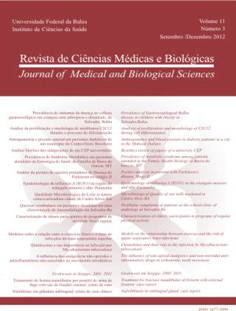Quimiocinas e sua importância na infecção por Mycobacterium tuberculosis
DOI:
https://doi.org/10.9771/cmbio.v11i3.6021Keywords:
Granuloma. Quimiocinas. Mycobacterium tuberculosis.Abstract
As quimiocinas (citocinas quimiotáticas) são uma grande família de citocinas estruturalmente homólogas, que recrutam células de defesa do hospedeiro para os locais de infecção, e regulam o tráfego de linfócitos e outros leucócitos através dos tecidos linfóides periférico. Especificamente no combate às bactérias intracelulares, o tráfego e a recirculação celular são processos cruciais orquestrados por estas moléculas e seus receptores. O Mycobacterium tuberculosis é o agente etiológico da tuberculose humana, e possui a capacidade de sobreviver e de se replicar dentro dos fagócitos, tornando-se inacessível aos anticorpos circulantes. Consequentemente, sua eliminação depende basicamente de mecanismos da imunidade mediada por células, envolvendo a produção de diversas citocinas, com interações bastante complexas. Desta forma, na dinâmica da resposta imune contra o M. tuberculosis, as quimiocinas têm função primordial na formação e manutenção do granuloma, principal estrutura formada na tentativa de conter a disseminação deste patógeno no organismo. Portanto, pretende-se discutir a importância das quimiocinas no contexto da imunidade e/ou proteção contra a infecção com M. tuberculosis, relacionando-se os principais avanços na pesquisa sobre esta interação.
Chemokines and their role in the infection by Mycobacterium tuberculosis
Chemokines (chemotactic cytokines) are a large family of structurally homologous cytokines, which recruit host defense cells to infection sites, and regulate the traffic of lymphocytes and other leukocytes through peripheral lymphoid tissues. Specifically in the defense against intracellular bacteria, the cell traffic and recirculation are critical processes orchestrated by these molecules and their receptors. Mycobacterium tuberculosis is the etiologic agent of human tuberculosis, and has the ability to survive and replicate within phagocytes, making it inaccessible to antibodies. Consequently, its elimination depends largely on the mechanisms of cell-mediated immunity, involving the production of several cytokines, with very complex interactions. Thus, in the dynamics of the immune response to M. tuberculosis, chemokines have primary role in the formation and maintenance of the granuloma, the main structure formed in an attempt to contain the spread of this pathogen in the body. Therefore, we intend to discuss the importance of chemokines in the context of immunity and/or protection against infection with M. tuberculosis, relating to major advances in research on this interaction.
Keywords: Granuloma. Chemokines. Mycobacterium tuberculosis.
Downloads
Downloads
Published
How to Cite
Issue
Section
License
The Journal of Medical and Biological Sciences reserves all copyrights of published works, including translations, allowing, however, their subsequent reproduction as transcription, with proper citation of source, through the Creative Commons license. The periodical has free and free access.


